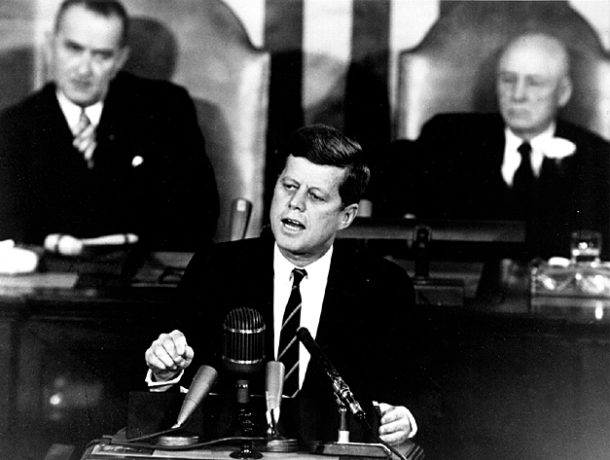
Fifty-six years ago this week, President John F. Kennedy boldly proposed that the United States conduct a manned lunar landing before the end of the 1960’s. The President’s clarion call to glory was delivered during a special session of the United States Congress which focused on what he called “urgent national needs”.
The transcript of that historic speech given on Friday, 25 May 1962 indicates that the ninth and last issue addressed by President Kennedy was simply entitled SPACE. The most stirring words of that portion of his speech may well be these:
“I believe that this nation should commit itself to achieving the goal, before this decade is out, of landing a man on the moon and returning him safely to the earth. No single space project in this period will be more impressive to mankind, or more important for the long-range exploration of space; and none will be so difficult or expensive to accomplish.”
Although he did not live to see the fulfillment of that goal, history shows that 8 years, 1 month, and 26 days later, the United States of America indeed landed men on the moon and returned them safely to the earth before the decade of the 1960’s was concluded.
Mission Accomplished, Mr. President.
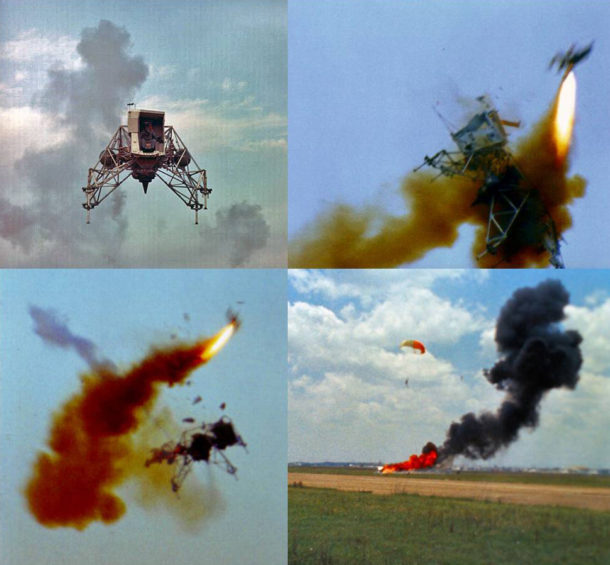
Forty-nine years ago this month, NASA Astronaut Neil A. Armstrong narrowly escaped with his life when he was forced to eject from the Lunar Landing Research Vehicle in which he was training. Armstrong punched-out only 200 feet above ground level and spent just 4 seconds in the silk before safely landing.
The Lunar Module (LM) was the vehicle used by Apollo astronauts to land on and depart from the lunar surface. This unique spacecraft consisted of separate descent and ascent rocket-powered stages. The powered descent phase was initiated at 50,000 feet AGL and continued all the way to landing. The powered ascent phase lasted from lunar lift-off to 60,000 feet AGL.
It was recognized early in the Apollo Program that landing a spacecraft on the lunar surface under vacuum conditions would be very challenging to say the least. To maximize their chances for doing so safely, Apollo astronauts would need piloting practice prior to a lunar landing mission. And they would need an earth-bound vehicle that flew like the LM to get that practice.
The Lunar Landing Research Vehicle (LLRV) was the answer to the above. The LLRV employed a turbojet engine that provided vertical thrust to cancel five-sixths of its weight since the gravity on the Moon is one-sixth that of Earth. The vehicle was also configured with dual lift rockets to provide vertical and horizontal motion. LLRV 3-axis attitude control was provided by a series of 16 small thrusters.
The LLRV was described by one historical NASA document as being “unconventional, contrary and ugly”. Known as the “Flying Bedstead”, the LLRV was designed for the specific purpose of simulating LM flight during the terminal phase of a lunar landing. The LLRV was not easy to fly in the “low and slow” flight regime in which it operated. The type was aesthetically unattractive in the extreme.
A pair of LLRV’s were constructed by Bell Aerosystems and flight tested at what is now the NASA Dryden Flight Research Center starting in October 1964. These vehicles were subsequently shipped to Ellington Air Force Base in Texas by early 1967. A number of flight crew, including Neil Armstrong, began LLRV flight training shortly thereafter.
Neil Armstrong made his first LLRV flight on Monday, 27 March 1967 in LLRV No. 1. (This occurred two months after the horrific Apollo 1 Fire.) Armstrong continued flight training in the LLRV over the next year in preparation for what would ultimately be the first manned lunar landing attempt in July of 1969
On Monday, 06 May 1968, Armstrong was flying LLRV No. 1 when the vehicle began losing altitude as its lift rockets lost thrust. Using turbojet power, Armstrong was able to get the LLRV to climb. As he did so, the vehicle made an uncommanded pitch-up and roll over. The attitude control system was unresponsive. The pilot had no choice but to eject.
Neil Armstrong ejected from the LLRV at 200 feet AGL as LLRV No. 1 crashed to destruction. The pilot was subjected to an acceleration of 14 G’s as his rocket-powered, vertically-seeking ejection seat functioned as designed. Armstrong got a full chute, but made only a few swings in same before safely touching-down back on terra firma. His only injury was to his tongue, which he accidently bit at the moment of ejection seat rocket motor ignition.
A mishap investigation board attributed the LLRV mishap to a design deficiency that allowed the helium gas pressurant of the lift rocket and attitude control system fuel tanks to be be accidently depleted. Thus, propellants could not be delivered to the lift rockets and attitude control system thrusters.
Neil Armstrong and indeed all of the Apollo astronauts who landed on the Moon trained in improved variants of the LLRV known as the Lunar Landing Training Vehicle (LLTV). This training was absolutely crucial to the success of the half-dozen Apollo crews who landed on the Moon. Indeed, there was no other way to adequately simulate moon landings except by flying the LLTV.
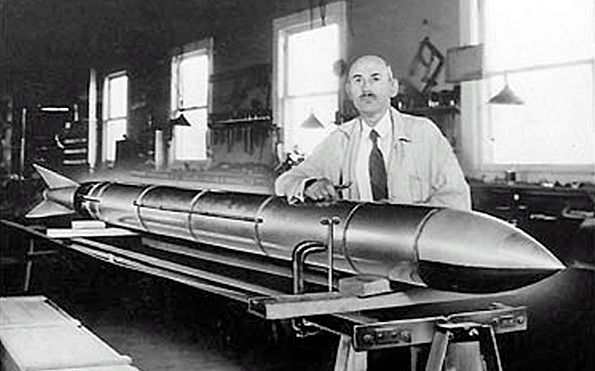
Eighty-two years ago this month, pioneering rocket scientist Robert H. Goddard and staff fired a liquid-fueled rocket to a record altitude of 7,500 feet above ground level. The record-setting flight took place at Roswell, New Mexico.
Robert Hutchings Goddard was born in Worcester, Massachusetts on Thursday, 05 October 1882. He was enamored with flight, pyrotechnics, rockets and science fiction from an early age. By the time he was 17, Goddard knew that his life’s work would combine all of these interests.
Goddard was a sickly youth, but spent his well moments as a voracious reader of all manner of science-oriented literature. He graduated in 1904 from South High School in Worcester as the valedictorian of his class. He matriculated at Worcester Polytechnic and graduated with a Bachelor of Science degree in physics in 1908. A Master of Science degree and Ph.D. from Worcester’s Clark University followed in 1910 and 1911, respectively.
Goddard spent the next eight years of his life working on numerous propulsion and rocket-related projects. Then, in 1919, he published his now-famous scientific treatise entitled A Method of Reaching Extreme Altitudes. In that paper, the press glommed on to Goddard’s passing mention that a multi-staged rocket could conceivably fly all the way to the Moon.
Goddard was roundly ridiculed for his fanciful prognostications about Moon flight. The New York Times was especially derogatory in its estimation of Goddard’s ideas and accused him of junk science. A Times editorial even criticized Goddard for his ”misconception” that a rocket could produce thrust in the vacuum of space.
Even the U.S. government largely ignored Goddard. This scornful treatment to which Goddard was subject hurt him profoundly. So much so that he spent the remainder of his life alienated from the denizens of the press as well as the dolts of governmental employ.
Despite the blow to his professional reputation, Goddard resolutely pressed on with his rocket research. Indeed, after more that five years of intense development effort, Goddard and his staff launched the first liquid-fueled rocket on Tuesday, 16 March 1926 in Auburn, Massachusetts. The flight duration was short (2.5 seconds) and the peak altitude tiny (41 feet), but Goddard proved that liquid rocket propulsion was feasible.
Goddard’s liquid-fueled rocket testing would ultimately lead him from the countryside of New England to the desert of the Great South West. With financial support from Harry Guggenheim and the public backing of Charles Lindbergh, Goddard transfered his testing activities to Roswell, New Mexico in 1930. He would continue liquid-fueled rocket testing there until May 1941.
On Friday, 31 May 1935, experimental rocket flight A-8 took to the air from Goddard’s Roswell, New Mexico test site at 1430 UTC. Roughly 15 feet in length and weighing approximately 90 pounds at lift-off, the 9-inch diameter A-8 achieved a maximum altitude of 7,500 feet (1.23 nautical miles) above the desert floor. Only a flight in March of 1937 would go higher (9,000 feet).
Robert Goddard was ultimately credited with 214 U.S. patents for his rocket development work. Only 83 were awarded in his life time. His far-reaching inventions included rocket nozzle design, regenerativley cooled rocket engines, turbopumps, thrust vector controls, gyroscopic control systems and more.
Goddard died at the age of 62 from throat cancer in Baltimore, Maryland on Friday, 10 August 1945. Many years would pass before the full import of his accomplishments was comprehended. Then, the posthumously-bestowed recognition came in torrents. In 1959, Congress issued a special gold medal in Goddard’s honor. The Goddard Spaceflight Center was so named by NASA in 1959 as well. Many more such bestowals followed.
Perhaps the most meaningful of the recognitions ever accorded Robert Hutchings Goddard occurred 24 years after his passing. It was in connection with the first manned lunar landing in July of 1969. And it was poetic not only in terms of its substance and timing, but more particularly in light of the source from whence the recognition came.
A terse statement in the New York Times corrected a long-standing injustice. It read: “Further investigation and experimentation have confirmed the findings of Issac Newton in the 17th century, and it is now definitely established that a rocket can function in a vaccum as well as in an atmosphere. The Times regrets the error.”
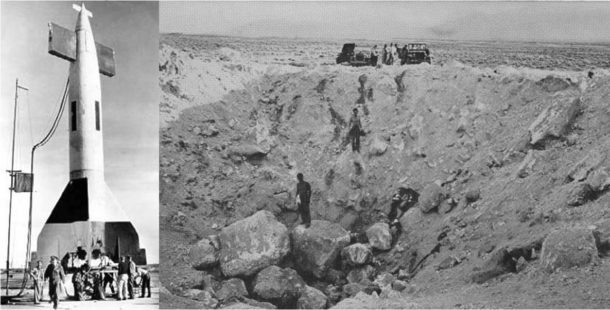
Seventy years ago this month, a Hermes II experimental missile, launched on a flight test out of White Sands Proving Ground, strayed from the test range and impacted near Ciudad Juarez, Mexico. The non-fatal mishap was later attributed to a breakdown in basic range safety protocol.
The V2 missile (Vengeance Weapon No. 2) was developed by Nazi Germany during World War II for the purpose of attacking Allied population centers. As such, it was the world’s first ballistic missile. History records that more than 3,100 V2’s were fired in anger, with London, England and Antwerp, Belgium being the prime targets. Approximately 7,200 people lost their lives in V2 attacks between September 1944 and March 1945.
The V2 as flown by the Third Reich measured 46 feet in length and had a maximum diameter of 5.4 feet. Launch weight was 28,000 lbs. The V2’s rocket motor produced a maximum thrust of about 60,000 lbs at sea level. Ethyl alcohol and liquid oxygen served as fuel and oxidizer, respectively. Approximately 19,000 pounds of propellants were consumed in 65 seconds of boost flight.
The V2’s payload was an explosive warhead weighing about 1,600 lbs. The fearsome missile’s kinematic performance was impressive for its time. Maximum velocity was around 5,200 ft/sec. After burnout, the rocket followed a ballistic flight path all the way to the target. Maximum altitude and range for wartime missions was on the order of 50 nm and 175 nm, respectively.
With the defeat of Nazi Germany, both the United States and the Soviet Union gained access to a large number of V2 missiles and many of the German rocket scientists who developed the weapon. The United States shipped 300 rail freight cars full of V2 missile components back home. Under Operation Paperclip, some 126 German engineering and scientific personnel were expatriated to the United States. Initially operating out of Fort Bliss, Texas and White Sands Proving Ground (WSPG), New Mexico, these men were destined to make major contributions to the American space program. Among their number was one Werhner von Braun.
Sixty-seven V2 missiles were launched from White Sands Proving Ground (WSPG) between 1946 and 1952. These flights gave the United States invaluable experience in all aspects of rocket assembly, handling, fueling, launching and tracking. Indeed, V2 rocket technology and lessons-learned were applied in the development of all subsequent American launch vehicles ranging from the Redstone to the Saturn V. WSPG V2’s were also used to conduct numerous high altitude and space research experiments. Many aerospace “firsts” were achieved along the way. The first biological space payloads, first photographs of earth from space and the first large two-stage rocket flights involved the former vengeance weapon.
Rocket system reliability was not particularly good in the 1940’s and 1950’s. For instance, only 68% of the WSPG V2 flights were considered successful. Range safety was in its infancy too. In particular, the comprehensive range safety protocol that governs flight operations at today’s test ranges did not yet exist. This state of affairs was largely due to the fact that much of the systems knowledge and operations lessons-learned required to establish such a protocol had yet to be acquired. An incident that occurred in May of 1947 serves to underscore the reliability and safety issues just noted.
The Hermes II missile (RTV-G-3/RV-A-3) was a derivative of the basic V2 vehicle. The payload was a forward-mounted, winged, ramjet engine test bed. The V2’s tail surfaces were enlarged to counter the destabilizing influence of the payload’s wing group. The idea was to get the payload up to a Mach number beyond 3 and separate it from the V2 booster. Following separation, the ramjet pack would be ignited and thrust established. The payload would then fly a programmed altitude-Mach number flight profile. While ambitious on several levels, the project was certainly emblematic of this era of aerospace history wherein all manner of ideas took to the skies.
On Thursday, 29 May 1947, Hermes II was fired from Launch Complex 33 at White Sands Proving Ground. It was approximately 1930 hours local time. It is noted that the ramjet pack was not active for this first flight. The Hermes test vehicle was supposed to pitch to the north and fly uprange. Instead, it pitched to the south and backrange toward El Paso, Texas. Post-flight analysis revealed that the new inertial guidance system employed by the Hermes missile had been wired backwards! This human error directly and adversely affected rocket system reliability.
The WSPG Range Safety Officer(RSO) had both the authority and responsibility to hit the destruct button once it was obvious that the Hermes II was errant. However, a project scientist physically restrained the RSO from doing so! Apparently, the scientist was of the (evidently strong) opinion that the test vehicle’s propellant load should not be wasted on such trivial grounds as the safety of the El Paso populace. Unimpeded now, the errant rocket continued its flight. Range safety protocol would have to be improved and understood by all participants prior to the next flight!
The Hermes II reached a maximum altitude of 35 nm on its unplanned trip to the south. During its 5 -minute flight, the vehicle overflew the city of El Paso and impacted near the Tepeyac Cemetery located 3.5 miles south of Ciudad Juarez, Mexico. The quasi-Mach 1 impact formed a crater that measured 50 feet in width and 24 feet in depth. Enterprising local residents gathered what little airframe wreckage that survived impact and sold it to souvenir seekers!
United States Army authorities quickly arrived on scene to ascertain the extent of the damage caused by the errant missile’s unannounced and unwelcome arrival. Happily, no lives were lost. Profuse apologies were delivered to and graciously accepted by Mexican government officials. The United States paid for all damages and effected a complete clean-up and remediation of the impact site.
A member of the team of expatriated German scientists who conducted the Hermes II flight test later was quoted as saying: “We were the first German unit to not only infiltrate the United States, but to attack Mexico from US soil!” Not nearly so amused, the Army tightened-up range safety protocol at WSPG in the aftermath of the international incident. Interestingly, historical evidence points to the likelihood that the Hermes II vehicle never did carry an active ramjet payload on test flights out of WSPG.
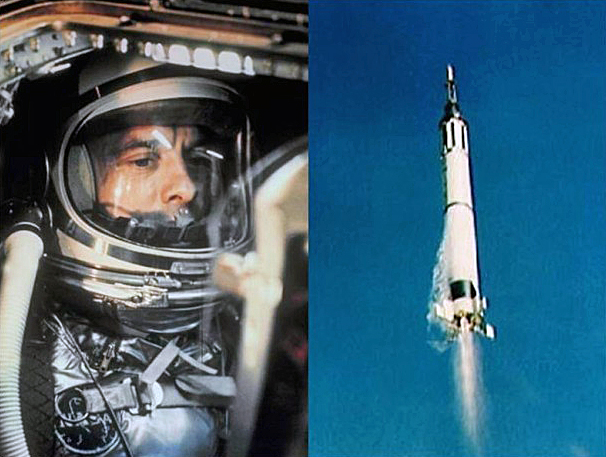
Fifty-six years ago this week, United States Navy Commander Alan Bartlett Shepard, Jr. became the first American to be launched into space. Shepard named his Mercury spacecraft Freedom 7.
Officially designated as Mercury-Redstone 3 (MR-3) by NASA, the mission was America’s first true attempt to put a man into space. MR-3 was a sub-orbital flight. This meant that the spacecraft would travel along an arcing parabolic flight path having a high point of about 115 nautical miles and a total range of roughly 300 nautical miles. Total flight time would be about 15 minutes.
The Mercury spacecraft was designed to accommodate a single crew member. With a length of 9.5 feet and a base diameter of 6.5 feet, the vehicle was less than commodious. The fit was so tight that it would not be inaccurate to say that the astronaut wore the vehicle. Suffice it to say that a claustrophobic would not enjoy a trip into space aboard the spacecraft.
Despite its diminutive size, the 2,500-pound Mercury spacecraft (or capsule as it came to be referred to) was a marvel of aerospace engineering. It had all the systems required of a space-faring craft. Key among these were flight attitude, electrical power, communications, environmental control, reaction control, retro-fire package, and recovery systems.
The Redstone booster was an Intermediate Range Ballistic Missile (IRBM) modified for the manned mission. The Redstone’s uprated A-7 rocket engine generated 78,000 pounds of thrust at sea level. Alcohol and liquid oxygen served as propellants. The Mercury-Redstone combination stood 83 feet in length and weighed 66,000 pounds at lift-off.
On Friday, 05 May 1961, MR-3 lifted-off from Cape Canaveral’s Launch Complex 5 at 14:34:13 UTC. Alan Shepard went to work quickly calling out various spacecraft parameters and mission events. The astronaut would experience a maximum acceleration of 6.5 g’s on the ride upstairs.
Nearing apogee, Shepard manually controlled Freedom 7 in all 3 axes. In doing so, he positioned the capsule in the required 34-degree nose-down attitude. Retro-fire occurred on-time and the retro package was jettisoned without incident. Shepard then pitched the spacecraft nose to 14 degrees above the horizon preparatory to reentry into the earth’s atmosphere.
Reentry forces quickly built-up on the plunge back into the atmosphere with Shepard enduring a maximum deceleration of 11.6 g’s. He had trained for more than 12 g’s prior to flight. At 21,000 feet, a 6-foot droghue chute was deployed followed by the 63-foot main chute at 10,000 feet. Freedom 7 splashed-down in the Atlantic Ocean 15 minutes and 28 seconds after lift-off.
Following splashdown, Shepard egressed Freedom 7 and was retreived from the ocean’s surface by a recovery helicopter. Both he and Freedom 7 were safely onboard the carrier USS Lake Champlain within 11 minutes of landing. During his brief flight, Shepard had reached a maximum speed of 5,180 mph, flown as high as 116.5 nautical miles and traveled 302 nautical miles downrange.
The flight of Freedom 7 had much the same effect on the Nation as did Lindbergh’s solo crossing of the Atlantic in 1927. However, in light of the Cold War fight against the world-wide spread of Soviet communism, Shepard’s flight was arguably more important. Indeed, Alan Shepard became the first of what Tom Wolfe called in his classic book The Right Stuff, the American single combat warrior.
For his heroic MR-3 efforts, Alan Shepard was awarded the Distinguished Service Medal by an appreciative nation. In February 1971, Alan Shepard walked on the surface of the Moon as Commander of Apollo 14. He was the lone member of the original Mercury Seven astronauts to do so. Shepard was awarded the Congressional Space Medal of Freedom in 1978.
Alan Shepard succumbed to leukemia in July of 1998 at the age of 74. In tribute to this American space hero, naval aviator and US Naval Academy graduate, Alan Shepard’s Freedom 7 spacecraft now resides in a place of honor at the United States Naval Academy in Annapolis, Maryland.






